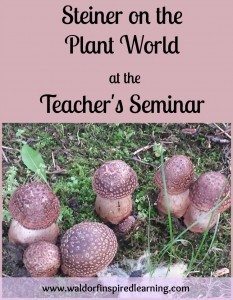How is a meadow like a tree? In Discussion Ten (the afternoon lecture on day ten of the first Waldorf teacher training in 1919), Steiner says that, “…when we look at a tree, it’s as if someone had taken the meadow, lifted it up, and rounded it into an arch; only then do we find many flowers growing very high all over it.”
 Of course, this discussion first begins with two speech exercises that are really more like tongue twisters for speech practice. Steiner felt that these verses don’t need to make sense necessarily. Their purpose is more to warm up our bodies and regulate our breathing.
Of course, this discussion first begins with two speech exercises that are really more like tongue twisters for speech practice. Steiner felt that these verses don’t need to make sense necessarily. Their purpose is more to warm up our bodies and regulate our breathing.
Then the group of teachers in training launches into a discussion about the plant world. You may recall that just “yesterday” in Discussion Nine, Steiner spoke to the teachers about Give Children a Pictorial Survey of the Plant World. (You can click the link to read reflections on that lecture.)
 This subject is coming up again because now it’s time for students to “study the plant kingdom on a more scientific basis.” And I’m guessing the teachers had some more questions! Here is Steiner’s key point:
This subject is coming up again because now it’s time for students to “study the plant kingdom on a more scientific basis.” And I’m guessing the teachers had some more questions! Here is Steiner’s key point:
“All children, who in their youth learn to know plants according to scientific principles, should first learn about them as we have described — that is, by comparing them with soul qualities. Later they can study the plant system more scientifically.”
This is an important distinction that could really be applied to all subjects in the Waldorf curriculum: begin “first presenting ideas that relate to the feeling life” before moving on to a more scientific approach.
One great thing about this discussion is that Steiner gives some wonderful examples!
“The plant realm is the soul world of the Earth made visible. The carnation is a flirt. The sunflower an old peasant. The sunflower’s shining face is like a jolly old country rustic. Plants with very big leaves would express, in terms of soul life, lack of success in a job, taking a long time with everything, clumsiness, and especially an inability to finish anything; we think that someone has finished, but the person is still at it. Look for the soul element in the plant forms!”
To me, this is like describing the essence of a thing. We want to start with that essence, how we perceive something, and move from feelings to form to intellect. (Aha, like heart, hands, head!)
Here is Steiner again, giving an example of how teachers might speak to the children:
“Look at this buttercup,” or any plant we dig out of the soil, showing the root below, the stalk, leaves, blossoms, and then the stamens and pistol, from which the fruit will develop. Let the child look at a plant like this. Then show a tree and say, “Imagine this tree next to the plant. What can you tell me about the tree? Yes, it also has roots below of course, but instead of a stalk, it has a trunk. Then it spreads its branches and it’s as if the real plants grew on these branches, because many leaves and flowers can be found there; it’s as if little plants were growing on the branches above.”
In this discussion, Steiner is so much more conversational than I often imagine him to be! He is asking the children to reflect on what they see, to observe with a sense of wonder, asking things like “what does this remind you of?”
As homeschoolers, this inspires us (Alison and Jean, we hope you, too!) to invite life and imagination into the lessons. We can make a suggestion about the essence of different plants and listen to the children’s reflections, too. In that way, we start with the feelings.
Do you find yourself able to take Steiner’s indications as a jumping off point? Or, do you find yourself feeling a little anxious that there’s one right way and you just aren’t sure what it is?
Please share in the comments!
The Steiner Cafe is a place to explore and reflect on the lectures that Rudolf Steiner gave at the Teacher’s Seminar in 1919, the very first Waldorf teacher training. Each month here, we ponder one day of the seminar.
For reflections on previous lectures, check out The Steiner Cafe page.
These lectures are published in three books; the morning lectures in The Foundations of Human Experience; later morning lectures in Practical Advice to Teachers; and afternoon lectures in Discussions with Teachers. We invite you to pick up the books and read along.
If you prefer, you can read online at www.rsarchive.org, or listen at www.rudolfsteineraudio.com. Or, just meet us here each Thursday or Friday at The Steiner Cafe for some lively discussion.
Lot’s of options! Hope you’ll join us.



One Comment